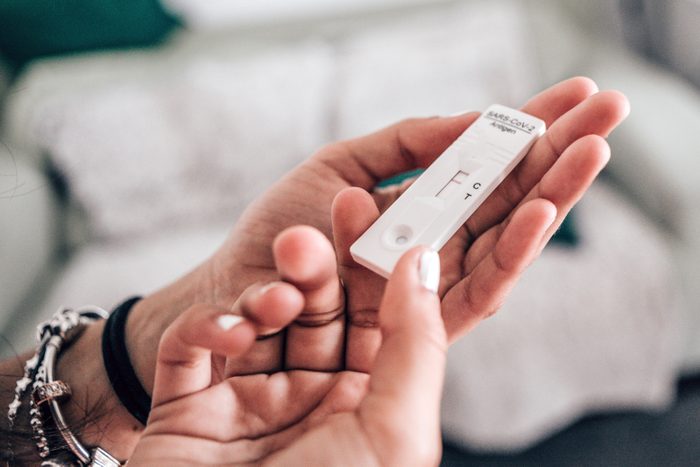New Study: If You Test for COVID on This Day of Symptoms, You May Be Testing Too Early
Updated: Oct. 03, 2023

Just-released research suggests that along with evolving variants comes a change in how quickly COVID tests are picking up signs of the virus.
You’re experiencing non-specific cold symptoms—say a cough, congestion, a low-grade fever, and feeling pretty crummy all around. Is it the new COVID variant, a common cold or the flu?
You head to your medicine cabinet to take a COVID test, which yields a negative result—so you’re clearly in the clear, right? Possibly not. A new pathology study published in late September 2023 in the peer-reviewed medical journal, Clinical Infectious Diseases, suggests that while you believe you’re being cautious by testing for COVID at the first sign of symptoms, there may be such thing as testing several days too early.
This study followed individuals who were experiencing COVID-19 symptoms. Out of the 348 people who tested positive for the virus, it was found that the at-home antigen rapid diagnostic test could detect the most positive results on the fourth day of COVID symptoms. On the first day, these tests could only identify 30% to 60% of positive cases, which increased to approximately 60% to 75% on the third day. However, by the fourth day, up to 93% of cases were detected accurately.
Why are people testing positive later than we’ve believed?
Researchers theorized that immunity and previous vaccinations might influence how quickly these tests can detect viral load in the body. Essentially, the population’s level of immunity to COVID and its variants can result in the body initially fighting off new infections, leading to lower viral loads in the first few days and false negatives in the tests. More than 90% of the people with new COVID infections in the study had already had a strain of COVID, were vaccinated, or both.
New Data: Long COVID Is Most Prevalent in This Age Group
What to do if you have symptoms
If you have concerning symptoms, Dr. Darien Sutton, ABC News medical correspondent, advises individuals to “mask up” if an initial COVID test comes back negative. Whether the symptoms are caused by COVID, the flu or the common cold, wearing a mask can help prevent transmission to others during the most contagious phase.
Additionally, Dr. Sutton adds, if your symptoms persist, it’s recommended to repeat the test after 48 hours. If you’ve been in close contact with someone who later tests positive (considered a “high-risk” interaction due to prolonged exposure), wearing a mask and testing again in three to five days is advisable.
The new Eris variant could have its own effect on positive test rates
It’s worth noting that new variants could potentially affect the timing of viral load detection on at-home tests. According to John Brownstein, PhD, the chief innovation officer at Boston Children’s Hospital: “New variants may cause differences in the timing of viral load,” which can impact the optimal timing for test accuracy.
The Clinical Infectious Diseases study was conducted when Omicron was the dominant variant, but now Eris is the main new strain people are encountering. Again, be sure to repeat a negative COVID test or follow up with a healthcare practitioner if you notice possible COVID symptoms.
Here’s the Arm You Should Get Your COVID Shot In, New Study Finds
Don’t toss those expired COVID tests!
Lastly, if you have an expired at-home COVID test, don’t discard it immediately. Instead, check the FDA website to see if your test has an extended expiration date. The FDA has extended the expiration dates of several at-home tests that have been clinically demonstrated to remain effective beyond the initial expiration date printed on the package.
If your test is expired and does not have an extended date, it’s best to toss it, as it could no longer be accurate.















